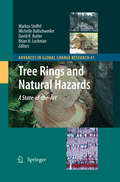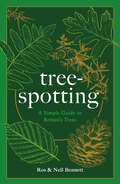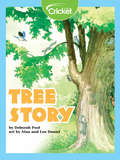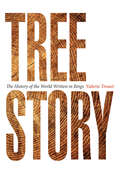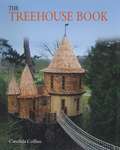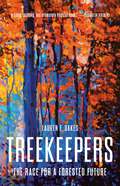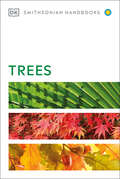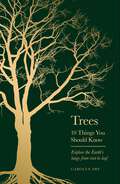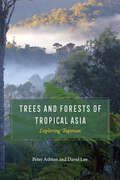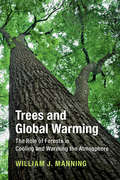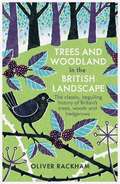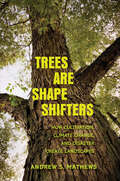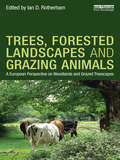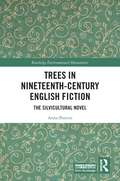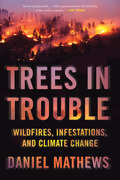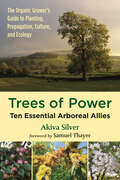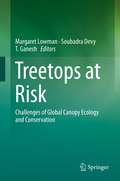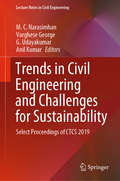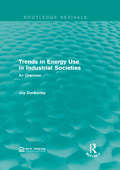- Table View
- List View
Tree Plantation Extractivism in Chile: Territories, Fundamental Human Needs, and Resistance (Routledge Studies of the Extractive Industries and Sustainable Development)
by Alejandro Mora-MottaThis book examines how extractivism transforms territories and affects the well-being of rural people, drawing on in-depth fieldwork conducted on tree plantations in Chile.The book argues that pine and eucalyptus monoculture plantations in southern Chile are a form of extractivism representing a mode of nature appropriation that captures large amounts of natural resources to produce wooden-based raw materials with little processing and an export-oriented focus. The book discusses the nexus of extractivism, territorial transformations, well-being, and emerging resistances using a participatory action research methodological approach in the Region of Los Ríos, southern Chile. The findings show how the configuration of an extractivist logging enclave generated a substantial and irrevocable reordering of human-nature relations, resulting in the territorial and ontological occupation of rural places that disrupted the fundamental human needs of peasants and indigenous people. The book maintains that Chile's green growth development approach does not challenge the consolidated tree plantation enclave controlled by large multinationals. Instead, green growth legitimises the extractivist logic. The book draws parallels with other countries and regions to contribute to wider debates surrounding these topics.This book will be of great interest to students and scholars of the extractive industries, development studies, political ecology, and natural resource governance.
Tree Rings and Natural Hazards
by Brian H. Luckman David R. Butler Markus Stoffel Michelle BollschweilerThe initial employment of tree rings in natural hazard studies was simply as a dating tool and rarely exploited other environmental information and records of damage contained within the tree. However, these unique, annually resolved, tree-ring records preserve valuable archives of past earth-surface processes on timescales of decades to centuries. As many of these processes are significant natural hazards, understanding their distribution, timing and controls provides valuable information that can assist in the prediction, mitigation and defence against these hazards and their effects on society. Tree Rings and Natural Hazards provides many illustrations of these themes, demonstrating the application of tree rings to studies of snow avalanches, rockfalls, landslides, floods, earthquakes, wildfires and several other processes. Several of the chapters are "classic studies", others represent recent applications using previously unpublished material. They illustrate the breadth and diverse applications of contemporary dendrogeomorphology and underline the growing potential to expand such studies, possibly leading to the establishment of a range of techniques and approaches that may become standard practice in the analysis of natural hazards in the future.
Tree Spiker: From Earth First to Lowbagging: My Struggles in Radical Environmental Action
by Mike Roselle Josh MahanLauded by some, despised by others, Mike Roselle is one of the most controversial figures in the crusade to protect the environment. Mike has succeeded in stopping a lumber project by spiking trees, struggled with death threats and the car bombing of fellow activist Judi Bari, endured countless days in jail, infiltrated the Nevada Test Site to delay nuclear bomb detonation, helped put a gas mask on Mount Rushmore's George Washington, and aided actor Woody Harelson in draping a banner up on the Golden Gate Bridge. He has spent over thirty years fighting back against big business, negligent management and the lawless actions of the government itself for the safety and preservation of our great earth. Tree Spiker: From Earth First! to Lowbagging: My Struggles in Radical Environmental Action is a fascinating autobiography from the front lines of a radical movement.
Tree-spotting: A Simple Guide to Britain's Trees
by Nell Bennett Ros BennettA beautifully illustrated guide to the marvellous and varied world of trees, and a fascinating introduction to the hidden secrets of 52 British species. Botanist and ecologist Ros Bennett has spent a lifetime helping people understand and identify plants and always hoped her daughter Nell would grow up to share her love of the natural world.During Nell's childhood years they spent much time exploring the local woods together. Here, Nell discovered the visual and tactile beauty of trees.In Tree-spotting, Ros and Nell have combined their backgrounds and talents to show you – through Ros's extensive experience and Nell's exquisite illustrations – how to identify 52 British trees simply and confidently.A beautiful and captivating insight into the wonderful world of trees, Tree-spotting burrows down into the history and hidden secrets of each species. It explores how our relationship with trees can be very personal, and will bring you closer to the natural world around you.
Tree-spotting: A Simple Guide to Britain's Trees
by Nell Bennett Ros BennettA beautifully illustrated guide to the marvellous and varied world of trees, and a fascinating introduction to the hidden secrets of 52 British species. Botanist and ecologist Ros Bennett has spent a lifetime helping people understand and identify plants and always hoped her daughter Nell would grow up to share her love of the natural world.During Nell's childhood years they spent much time exploring the local woods together. Here, Nell discovered the visual and tactile beauty of trees.In Tree-spotting, Ros and Nell have combined their backgrounds and talents to show you – through Ros's extensive experience and Nell's exquisite illustrations – how to identify 52 British trees simply and confidently.A beautiful and captivating insight into the wonderful world of trees, Tree-spotting burrows down into the history and hidden secrets of each species. It explores how our relationship with trees can be very personal, and will bring you closer to the natural world around you.
Tree Story
by Deborah PoolAt every stage in a tree's life cycle, it provides a home for many animals and insects.
Tree Story: The History of the World Written in Rings
by Valerie TrouetWhat if the stories of trees and people are more closely linked than we ever imagined?Winner of the World Wildlife Fund's 2020 Jan Wolkers PrizeOne of Science News's "Favorite Books of 2020" A New York Times "New and Noteworthy" BookA 2020 Woodland Book of the YearGold Winner of the 2020 Foreword INDIES Award in Ecology & EnvironmentBronze Winner of the 2021 Independent Publisher Book Award in Environment/EcologyPeople across the world know that to tell how old a tree is, you count its rings. Few people, however, know that research into tree rings has also made amazing contributions to our understanding of Earth's climate history and its influences on human civilization over the past 2,000 years. In her captivating book Tree Story, Valerie Trouet reveals how the seemingly simple and relatively familiar concept of counting tree rings has inspired far-reaching scientific breakthroughs that illuminate the complex interactions between nature and people.Trouet, a leading tree-ring scientist, takes us out into the field, from remote African villages to radioactive Russian forests, offering readers an insider's look at tree-ring research, a discipline known as dendrochronology. Tracing her own professional journey while exploring dendrochronology's history and applications, Trouet describes the basics of how tell-tale tree cores are collected and dated with ring-by-ring precision, explaining the unexpected and momentous insights we've gained from the resulting samples.Blending popular science, travelogue, and cultural history, Tree Story highlights exciting findings of tree-ring research, including the fate of lost pirate treasure, successful strategies for surviving California wildfire, the secret to Genghis Khan's victories, the connection between Egyptian pharaohs and volcanoes, and even the role of olives in the fall of Rome. These fascinating tales are deftly woven together to show us how dendrochronology sheds light on global climate dynamics and uncovers the clear links between humans and our leafy neighbors. Trouet delights us with her dedication to the tangible appeal of studying trees, a discipline that has taken her to austere and beautiful landscapes around the globe and has enabled scientists to solve long-pondered mysteries of Earth and its human inhabitants.
The Treehouse Book
by Candida CollinsThe Treehouse Book is a global round-up of the best in modern treehouse living. Tree houses have come of age. The image of a few planks nailed into the branches of a tree has changed into a new generation of specially designed and built structures, suitable as a playhouse, a study, or even a guestroom. Totally inhabitable and filled with designer furniture, plumbing, and electronic wizardry, the twenty tree houses featured in this book are to be admired, dreamed about, and even built. Featuring spectacular photography of exteriors set up among the trees, and interior shots that offer design ideas for living the &“high&” life, The Treehouse Book offers a fairy tale castle, a thatched cottage, a complete hotel, and much more. Each project was designed using computer technology and built using sustainable materials to create structures that only seem like fantasy. Each is cleverly fitted to the chosen trees, avoiding long-term damage to these remarkable structures. With a section on plans and building techniques to help the competent reader design and build a fabulous tree house for him or herself, The Treehouse Book will inspire everyone to dream about what life would be like leaving all cares and worries behind and below. From basic cabins suspended in the trees, to the unbelievable "High-Tech Hideaway," The Treehouse Book may inspire us to commission the retreat of our dreams ... or to get out the hammer and nails!
Treekeepers: The Race for a Forested Future
by Lauren E. Oakes&“A frank, probing, but ultimately hopeful book&” (Elizabeth Kolbert) that shows how the path from climate change to a habitable future winds through the world&’s forests In recent years, planting a tree has become a catchall to represent &“doing something good for the planet.&” Many companies commit to planting a tree with every purchase. But who plants those trees and where? Will they flourish and offer the benefits that people expect? Can all the individual efforts around the world help remedy the ever-looming climate crisis? In Treekeepers, Lauren E. Oakes takes us on a poetic and practical journey from the Scottish Highlands to the Panamanian jungle to meet the scientists, innovators, and local citizens who each offer part of the answer. Their work isn&’t just about planting lots of trees, but also about understanding what it takes to grow or regrow a forest and to protect what remains. Throughout, Oakes shows the complex roles of forests in the fight against climate change, and of the people who are giving trees a chance with hope for our mutual survival. Timely, meticulously reported, and ultimately optimistic, Treekeepers teaches us how to live with a sense of urgency in our warming world, to find beauty in the present for ourselves and our children, and to take action big or small.
Trees (Dk Handbooks Ser.)
by DKThe clearest and sharpest definition guide to over 500 species of trees from around the world. DK Handbook: Trees explains what a tree is, how trees are classified, and how to keep a record of the trees you have seen. Packed with over 1,000 full-colour photographs of more than 500 trees this book cuts through the complicated identification process to enable you to recognize a species instantly. To help in the initial stages of identification, the book provides a visual key that shows the differences between conifers, broadleaves, and palms, identifies each genus by leaf type, and guides you to the correct species entry. Every entry combines a precise description with annotated photographs to highlight the tree&’s chief characteristics and distinguishing features, and a full-colour illustration showing the spread, height, and leaf persistence of the species. A concise glossary defines technical and scientific terms. Compact enough to take out into the field or forest, DK Handbooks: Trees makes identifying nature&’s giants easier than ever before. Dive straight into this riveting reference guide to trees and explore: - Introduction provides an accessible primer on the basics of trees and identification.- Each entry includes at-a-glance facts for quick reference.- Photographs show close-ups of key details and highlight distinguishing features, making it easy to identify species.- A visual key of leaf type and genus makes identification simple when using the guide out and about Trees is a must-have guide nature lovers and naturalists, ramblers and hikers who want to identify and discover more about different trees.At DK, we believe in the power of discovery. So why stop there? Trees is part of DK&’s lovely little Handbook Series, where you can glide into the galaxies with Stars and Planets, showcase your knowledge with Shells and find out about Fossils.
Trees: 10 Things You Should Know
by Carolyn FryDiscover the wonders at the centre of our planet's ecosystem.In ten short and accessible essays, science and nature writer Carolyn Fry takes us on an awe-inspiring journey of the Earth's lungs. From what makes a plant a tree and the incredible impact of forests, to how trees are under attack and what we can do to save them, this book will enthral and inform on the monumental power of the humble tree.Trees: 10 things you should know is an essential introduction to why trees are so important, and why our lives depend on them!
Trees and Forests of Tropical Asia: Exploring Tapovan
by Peter Ashton David LeeInformed by decades of researching tropical Asian forests, a comprehensive, up-to-date, and beautifully illustrated synthesis of the natural history of this unique place. Trees and Forests of Tropical Asia invites readers on an expedition into the leafy, humid, forested landscapes of tropical Asia—the so-called tapovan, a Sanskrit word for the forest where knowledge is attained through tapasya, or inner struggle. Peter Ashton and David Lee, two of the world’s leading scholars on Asian tropical rain forests, reveal the geology and climate that have produced these unique forests, the diversity of species that inhabit them, the means by which rain forest tree species evolve to achieve unique ecological space, and the role of humans in modifying the landscapes over centuries. Following Peter Ashton’s extensive On the Forests of Tropical Asia, the first book to describe the forests of the entire tropical Asian region from India east to New Guinea, this new book provides a more condensed and updated overview of tropical Asian forests written accessibly for students as well as tropical forest biologists, ecologists, and conservation biologists.
Trees and Global Warming: The Role of Forests in Cooling and Warming the Atmosphere
by William J. ManningLarge-scale tree planting is advocated to provide additional atmospheric cooling and further reduce global warming. This raises a question about the present time: do trees cool or warm the atmosphere? This question does not have a simple yes or no answer. Examination of the greenhouse effect, global warming and the carbon cycle, and how trees and forests function provides the basis for understanding how forests might cool or warm the atmosphere. Results from research and models indicate that cooling or warming depends on where forests are located and the type and color of trees. Cooling generally prevails over warming, but this may change. This book will appeal to anyone interested in climate change, ecology and conservation.
Trees and Woodland in the British Landscape
by Dr Oliver RackhamA beautifully written classic of nature writing.'A masterly account...of supreme interest...a classic' Country LifeLong accepted as the best work on the subject, Oliver Rackham's book is both a comprehensive history of Britain's woodland and a field-work guide that presents trees individually and as part of the landscape.From prehistoric times, through the Roman period and into the Middle Ages, Oliver Rackham describes the changing character, role and history of trees and woodland. He concludes this definitive study with a section on the conservation and future of Britain's trees, woodlands and hedgerows.
Trees and Woodland in the British Landscape
by Oliver RackhamA beautifully written classic of nature writing.'A masterly account...of supreme interest...a classic' Country LifeLong accepted as the best work on the subject, Oliver Rackham's book is both a comprehensive history of Britain's woodland and a field-work guide that presents trees individually and as part of the landscape.From prehistoric times, through the Roman period and into the Middle Ages, Oliver Rackham describes the changing character, role and history of trees and woodland. He concludes this definitive study with a section on the conservation and future of Britain's trees, woodlands and hedgerows.
Trees Are Shape Shifters: How Cultivation, Climate Change, and Disaster Create Landscapes (Yale Agrarian Studies Series)
by Andrew S. MathewsAn exploration of the anthropogenic landscapes of Lucca, Italy, and how its people understand social and environmental change through cultivation In Italy and around the Mediterranean, almost every stone, every tree, and every hillside show traces of human activities. Situating climate change within the context of the Anthropocene, Andrew Mathews investigates how people in Lucca, Italy, make sense of social and environmental change by caring for the morphologies of trees and landscapes. He analyzes how people encounter climate change, not by thinking and talking about climate, but by caring for the environments around them. Maintaining landscape stability by caring for the forms of trees, rivers, and hillsides is a way that people link their experiences to the past and to larger scale political questions. The human-transformed landscapes of Italy are a harbinger of the experiences that all of us are likely to face, and addressing these disasters will call upon all of us to think about the human and natural histories of the landscapes we live in.
Trees, Forested Landscapes and Grazing Animals: A European Perspective on Woodlands and Grazed Treescapes
by Ian D. RotherhamIn this comprehensive book, the critical components of the European landscape – forest, parkland, and other grazed landscapes with trees are addressed. The book considers the history of grazed treed landscapes, of large grazing herbivores in Europe, and the implications of the past in shaping our environment today and in the future. Debates on the types of anciently grazed landscapes in Europe, and what they tell us about past and present ecology, have been especially topical and controversial recently. This treatment brings the current discussions and the latest research to a much wider audience. The book breaks new ground in broadening the scope of wood-pasture and woodland research to address sites and ecologies that have previously been overlooked but which hold potential keys to understanding landscape dynamics. Eminent contributors, including Oliver Rackham and Frans Vera, present a text which addresses the importance of history in understanding the past landscape, and the relevance of historical ecology and landscape studies in providing a future vision.
Trees in Nineteenth-Century English Fiction: The Silvicultural Novel (Routledge Environmental Humanities)
by Anna BurtonThis is a book about a longstanding network of writers and writings that celebrate the aesthetic, socio-political, scientific, ecological, geographical, and historical value of trees and tree spaces in the landscape; and it is a study of the effect of this tree-writing upon the novel form in the long nineteenth century. Trees in Nineteenth-Century English Fiction: The Silvicultural Novel identifies the picturesque thinker William Gilpin as a significant influence in this literary and environmental tradition. Remarks on Forest Scenery (1791) is formed by Gilpin’s own observations of trees, forests, and his New Forest home specifically; but it is also the product of tree-stories collected from ‘travellers and historians’ that came before him. This study tracks the impact of this accumulating arboreal discourse upon nineteenth-century environmental writers such as John Claudius Loudon, Jacob George Strutt, William Howitt, and Mary Roberts, and its influence on varied dialogues surrounding natural history, agriculture, landscaping, deforestation, and public health. Building upon this concept of an ongoing silvicultural discussion, the monograph examines how novelists in the realist mode engage with this discourse and use their understanding of arboreal space and its cultural worth in order to transform their own fictional environments. Through their novelistic framing of single trees, clumps, forests, ancient woodlands, and man-made plantations, Jane Austen, Elizabeth Gaskell, and Thomas Hardy feature as authors of particular interest. Collectively, in their environmental representations, these novelists engage with a broad range of silvicultural conversation in their writing of space at the beginning, middle, and end of the nineteenth century. This book will be of great interest to students, researchers, and academics working in the environmental humanities, long nineteenth-century literature, nature writing and environmental literature, environmental history, ecocriticism, and literature and science scholarship.
Trees in Trouble: Wildfires, Infestations, and Climate Change
by Daniel MathewsA troubling story of the devastating and compounding effects of climate change in the Western and Rocky Mountain states, told through in–depth reportage and conversations with ecologists, professional forest managers, park service scientists, burn boss, activists, and more. Climate change manifests in many ways across North America, but few as dramatic as the attacks on our western pine forests. In Trees in Trouble, Daniel Mathews tells the urgent story of this loss, accompanying burn crews and forest ecologists as they study the myriad risk factors and refine techniques for saving this important, limited resource.Mathews transports the reader from the exquisitely aromatic haze of ponderosa and Jeffrey pine groves to the fantastic gnarls and whorls of five–thousand–year–old bristlecone pines, from genetic test nurseries where white pine seedlings are deliberately infected with their mortal enemy to the hottest megafire sites and neighborhoods leveled by fire tornadoes or ember blizzards.Scrupulously researched, Trees in Trouble not only explores the devastating ripple effects of climate change, but also introduces us to the people devoting their lives to saving our forests. Mathews also offers hope: a new approach to managing western pine forests is underway. Trees in Trouble explores how we might succeed in sustaining our forests through the challenging transition to a new environment.
Trees of Power: Ten Essential Arboreal Allies
by null Akiva SilverThe organic grower&’s guide to planting, propagation, culture, and ecologyTrees are our allies in healing the world. Partnering with trees allows us to build soil, enhance biodiversity, increase wildlife populations, grow food and medicine, and pull carbon out of the atmosphere, sequestering it in the soil.Trees of Power explains how we can work with these arboreal allies, specifically focusing on propagation, planting, and individual species. Author Akiva Silver is an enthusiastic tree grower with years of experience running his own commercial nursery. In this book he clearly explains the most important concepts necessary for success with perennial woody plants. It&’s broken down into two parts: the first covering concepts and horticultural skills and the second with in-depth information on individual species. You&’ll learn different ways to propagate trees: by seed, grafting, layering, or with cuttings. These time-honored techniques make it easy for anyone to increase their stock of trees, simply and inexpensively.Ten chapters focus on the specific ecology, culture, and uses of different trees, ones that are common to North America and in other temperate parts of the world:Chestnut: The Bread TreeApples: The Magnetic CenterPoplar: The HomemakerAsh: Maker of WoodMulberry: The Giving TreeElderberry: The CaretakerHickory: Pillars of LifeHazelnut: The ProviderBlack Locust: The Restoration TreeBeech: The Root RunnerTrees of Power fills an urgent need for up-to-date information on some of our most important tree species, those that have multiple benefits for humans, animals, and nature. It also provides inspiration for new generations of tree stewards and caretakers who will not only benefit themselves, but leave a lasting legacy for future generations.Trees of Power is for everyone who wants to connect with trees. It is for the survivalist, the gardener, the homesteader, the forager, the permaculturist, the environmentalist, the parent, the schoolteacher, the farmer, and anyone who feels a deep kinship with these magnificent beings.
The Trees that Made Britain: Revised Edition
by Archie MilesAs the oldest living inhabitants on the planet, trees have played a major part in the way we live today, providing both the daily oxygen we breathe and the foundation of our nations heritage. Every native tree in Britain, whether its part of a grand avenue, a thriving hedgerow, an ancient wood or a colourful orchard, tells a different story. The Trees That Made Britain takes us on a journey of discovery to every corner of the nation. Through detailed portraits of individual tree species, author and photographer Archie Miles reveals the stories of the trees that have influenced the culture, myths and fabric of the nation. The book is full of surprising facts on how trees have been used by man over the centuries, from the oak used in the building of HMS Victory to ancient longbows made from yew, as well as practical advice on visiting some of Britains finest living examples. The combination of rich historical material and lyrical descriptions captures the essence of our native tree species.
Treetops at Risk: Challenges of Global Canopy Ecology and Conservation
by Margaret Lowman Soubadra Devy T. GaneshForest canopies not only support high terrestrial biodiversity but also represent a critical interface between the atmosphere and the earth. They provide goods and services to support diverse human communities and offer opportunities to explore sustainable use of these resources for many generations of local livelihoods. Forest canopies are important carbon sequestration units, and in this sense, serve as climate control for the planet. Canopies are important energy production centers for the planet, and serve as the basis for many food chains. The canopy can also act as a hook for education outreach and conservation, inspiring ecotourism through recreation and other sustainable uses such as treetop walks, zip lines, and birding. Despite these critical services provided by forest canopies, almost no dedicated research in the treetops was initiated until as recently as the late 1970s when single rope techniques were developed by mountaineering professionals and adapted for use in the canopy. Subsequently, an array of canopy access tools was designed in the 1980s and early 1990s that have opened up this "eighth continent" for global exploration and discovery. This volume uses the major findings of the 5th international canopy conference as a platform for organization, but it does not mimic the sessions and presentations of the conference itself. Instead, it builds on the important themes that emerged from the conference and solicits articles that represent future priorities and advancements for canopy science in the next decade. Despite the global efforts of hundreds of forest scientists over the past 3 decades, forests are degrading at an accelerated rate and biodiversity is increasingly threatened by human activities. Given these trends - despite the very best efforts of the world's best scientists - other approaches must be taken. This volume summarizes the issue of "treetops at risk" and assembles a global authorship to examine past accomplishments and future initiatives critical in forest conservation.
Trends in Civil Engineering and Challenges for Sustainability: Select Proceedings of CTCS 2019 (Lecture Notes in Civil Engineering #99)
by M. C. Narasimhan Varghese George G. Udayakumar Anil KumarThis book comprises selected papers from the International Conference on Civil Engineering Trends and Challenges for Sustainability (CTCS) 2019. The book presents latest research in several areas of civil engineering such as construction and structural engineering, geotechnical engineering, environmental engineering and sustainability, and geographical information systems. With a special emphasis on sustainable development, the book covers case studies and addresses key challenges in sustainability. The scope of the contents makes the book useful for students, researchers, and professionals interested in sustainable practices in civil engineering.
Trends in Computational Nanomechanics
by Traian DumitricaTrends in Computational Nanomechanics reviews recent advances in analytical and computational modeling frameworks to describe the mechanics of materials on scales ranging from the atomistic, through the microstructure or transitional, and up to the continuum. The book presents new approaches in the theory of nanosystems, recent developments in theoretical and computational methods for studying problems in which multiple length and/or time scales must be simultaneously resolved, as well as example applications in nanomechanics. This title will be a useful tool of reference for professionals, graduates and undergraduates interested in Computational Chemistry and Physics, Materials Science, Nanotechnology.
Trends in Energy Use in Industrial Societies: An Overview (Routledge Revivals)
by Joy DunkerleyTaken from a report for the Electric Power Research Institute, Joy Dunkerley’s study aims to clarify the relationship between energy consumption and economic output in industrialised countries. Originally published in 1980 and using data from 1972, this study uses cross-country comparisons of energy use to stress the importance of new supply options and measures of controlling energy use without affecting living standards whilst also discussing the impact of energy prices and economic growth in the countries studied. This title will be of interest to students of environmental studies.

